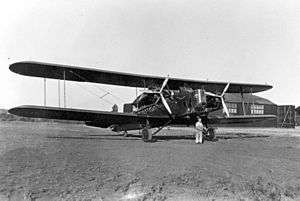Keystone B-5
| B-5 | |
|---|---|
 | |
| Keystone B-5A | |
| Role | Light bomber |
| Manufacturer | Keystone Aircraft |
| Primary user | United States Army Air Corps |
| Number built | 3 Y1B-5 27 B-5A |
| Developed from | Keystone B-3 |
The Keystone B-5 is a light bomber made for the United States Army Air Corps in the early 1930s. The B-5A was a Keystone B-3A with Wright Cyclone rather than Pratt & Whitney engines.
Design and development
Three B-3A (LB-10A) were reengined with Wright R-1750-3 radial engines and were redesignated Y1B-5. The Army Air Corps changed the design of the last 27 LB-10As on order, replacing the Pratt & Whitney R-1690 radial engines with the Wright R-1750-3. The Pratt & Whitney-powered aircraft were designated B-3A, and the Wright-powered aircraft became B-5A. They provided the backbone of the U.S. bomber force from then to 1934.
Operational history
B-5A were first line bombers of the United States for the period between 1930 and 1934. Afterwards, they remained in service primarily as observation aircraft until the early 1940s.
Variants
- LB-14
- Designed as LB-10 with 575 hp (429 kW) Pratt & Whitney GR-1860 engines; three ordered, but redesigned with 525 hp (392 kW) Wright R-1750-3 engines and delivered as the Y1B-5.
- Y1B-5
- Three pre-production aircraft redesignated from LB-14 before delivery.
- B-5A
- Wright R-1750-3 version originally ordered as B-3A, 27 built
Operators
Specifications (B-5A)
General characteristics
- Crew: 5
- Length: 48 ft 10 in (14.9 m)
- Wingspan: 74 ft 8 in (22.8 m)
- Height: 15 ft 9 in (4.8 m)
- Wing area: 1,145 ft² (106.4 m²)
- Empty weight: 7,705 lb (3,945 kg)
- Loaded weight: 12,952 lb (5,875 kg)
- Max. takeoff weight: lb (kg)
- Powerplant: 2 × Wright R-1750-3 radial engines, 525 hp (392 kW) each
Performance
- Maximum speed: 111 mph (97 kn, 179 km/h)
- Cruise speed: 98 mph (86 kn, 160 km/h)
- Range: 815 mi (707 nmi, 1,310 km)
- Service ceiling: 14,000 ft (4,270 m)
- Wing loading: 273.3 lb/f² (52.22 kg/m²)
- Power/mass: 0.0810 hp/lb (133 W/kg)
Armament
- Guns: 3 × .30 in (7.62 mm) Browning machine guns
- Bombs: 2,500 lb (1,100 kg); 4,000 lb (1,800 kg) on short runs
See also
- Related development
- Related lists
External links
| Wikimedia Commons has media related to Keystone B-5. |